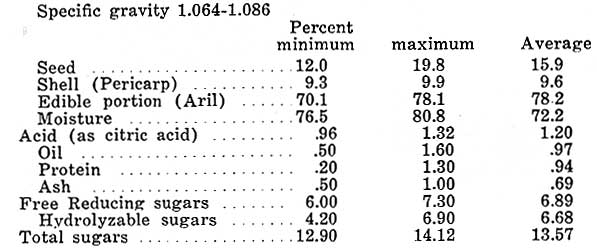ter period cold enough to provide a certain
degree of dormancy. It is evergreen and makes a fine dooryard tree as near
the equator as the Panama Canal, but does not fruit there. It has not fruited
too well in Cuba. It fruits sparingly in the cooler locations of Hawaii.
It is grown to some extent in parts of India and the Malay Peninsula. In
China its fruiting range on an extensive scale is limited to the southeastern
provinces of Kwangtung and Fukien although inferior fruit is produced in
the province of Szechwan. Its fruiting range in China is only about 300 miles
of latitude.
In a climate closely approximation our own, the Union of South Africa has bearing orchards of 5,000 trees, with a total of 40,000 trees and increasing rapidly. This development has been largely in the last twenty years. Their market is local, London and other European cities.
The Lychee has found difficulty in California, probably on account of the dry atmosphere, and has not been developed in Texas. The tree grows vigorously and fruits well in sections of South Florida which roughly correspond to the climatic conditions of the Lychee district in China.
Analysis of fresh Lychee fruits by Dr. Stahl, obtained from trees in Homestead, Fla., was as follows:
The fruits analyzed averaged approximately 30 to the pound
In a climate closely approximation our own, the Union of South Africa has bearing orchards of 5,000 trees, with a total of 40,000 trees and increasing rapidly. This development has been largely in the last twenty years. Their market is local, London and other European cities.
The Lychee has found difficulty in California, probably on account of the dry atmosphere, and has not been developed in Texas. The tree grows vigorously and fruits well in sections of South Florida which roughly correspond to the climatic conditions of the Lychee district in China.
Analysis of fresh Lychee fruits by Dr. Stahl, obtained from trees in Homestead, Fla., was as follows:
The fruits analyzed averaged approximately 30 to the pound

Wen Hsun Chen reports that the Lychee is a nourishing
food. The fresh fruits contain from 10 to 16% of sugars, and about 10%
protean. The pulp is acidulous, containing slightly over 1% of fruit acids,
which may help relieve thirst and increase appetite by action on digestive
enzymes. The fruit is valued in China as a remedy for certain diseases.
The Lychee also contains mineral elements which can help correct any diet
rich in proteins but lacking in mineral content. Lychee fruits are a very
good source of Vitamin C, a good source of Vitamin B, and a fair source
of E and D.
The oldest known monograph fully describing any fruit is said to be a fine description of the Lychee tree, its fruit, cultural requirements, etc., done in 1059 A. D. and for which the
The oldest known monograph fully describing any fruit is said to be a fine description of the Lychee tree, its fruit, cultural requirements, etc., done in 1059 A. D. and for which the